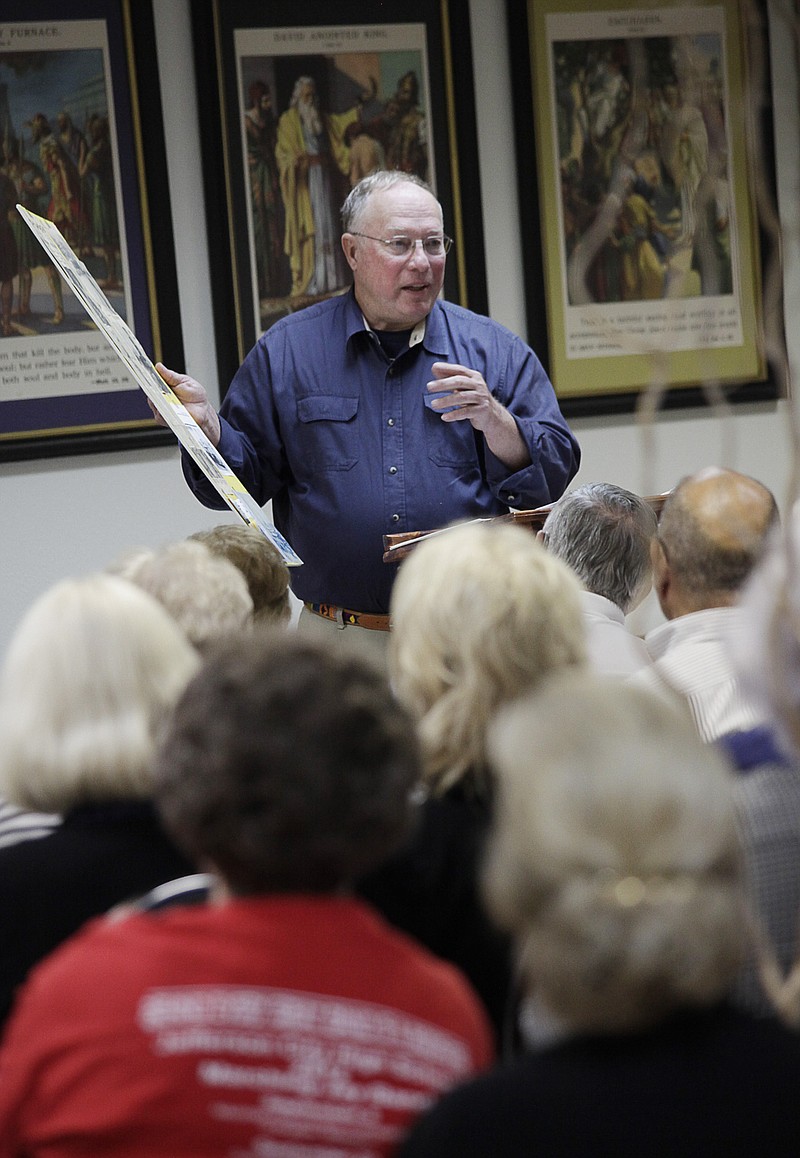Arriving by the carload, bringing old photographs and memorabilia of once-thriving communities that are now erased from all but some memories, nearly 100 attendees participated in the Cole County Historical Society's "Getting To Know Our Communities" presentation Thursday at St. John's Lutheran Church, in an area once known as Schubert.
Schubert and Osage City were brought back to life through the words of the evening's speakers, Rev. Gerald Scheperle of St. John's Lutheran Church of Schubert and Jim Hofmann, a native of Osage City. Pete Oetting of the Museum of Missouri Military History also spoke regarding the grand opening of the museum at its new location at the Ike Skelton Center on Militia Drive.
Organizers for the event said this is just one attempt by the historical society to extend the group's reach into all geographic areas of Cole County.
"The historical society has been mistaken in the past to be perceived as only a Jefferson City organization," Doris Schmutlzer, the evening's hostess, said. "This is not just an organization confined to Jefferson City. Cole County has a rich history with all of its communities and tonight we are highlighting some of that history."
Leah McNay, a historical society governing board member for six years, said she is currently planning a panel for July 15 at Tammy's Restaurant in Centertown.
McNay said the panel's topic is the history of the community known as Lookout, which later grew to be known as Centertown. She added an increased interest by members of the public in genealogy encouraged the historical society to branch out to rural Cole County.
"We feel like there is a great interest in the rural areas," McNay said. "A lot of people here tonight are dedicated genealogists who have researched their families and want to find out more about the towns where their family members lived."
Schubert and St. John's Lutheran Church
Dozens of pictures displayed Thursday told the tale of the community known as Schubert. The pictures showed how the vitality of the community became intertwined with the growth of St. John's Lutheran Church.
This unincorporated area in eastern Cole County got its origins in 1842 when Lorenz Schubert immigrated to the region from Germany. Lorenz arrived with $1,500, a small fortune at the time, and purchased 162 acres in Cole County.
One of Lorenz's two sons, George, would open Schubert's General Store. The area around the grocery store became synonymous with the proprietors of the store, Scheperle said.
Gaps in the history of the area and the church are blamed on the fire that destroyed the Schubert store, according to Scheperle. Aiding Scheperle and others in their pursuit of unearthing Schubert's history are later church records and an old church seal press.
"We know that first sermon delivered in English was in 1918," Scheperle said, adding that prior to 1918, church services were delivered in German. "By 1937, the congregation finally decided to introduce at least one sermon in English a month."
Osage City "The Pittsburgh of the West"
High hopes and expectations abounded for Osage City when it was founded. Advertisements were placed in the Missouri Gazette and the Boonslick Advertiser, the first two newspapers of Missouri, proclaiming the city to be an upcoming city of industry, mercantile and the perfect shipping market.
Unfortunately for those who bought lots in Osage City and for those that lived there for generations to come, expectations fell short, Hofmann said.
The Osage City native began his presentation by describing how Osage City's fate was tied to riverboat and railroad traffic, a relationship that would prove tumultuous at best for the city's inhabitants.
"The river dictated how city grew and the railroad dictated how the city declined," Hofmann said.
With a major shipyard built in the banks of the Osage River, the city quickly grew to be a profitable landing spot for steamboats like the Maid of the Osage.
During the Civil War the Union and Confederate forces would wrangle for control of the Osage City bridge over the Osage River, eventually leading to the Union forces burning the structure.
Despite lacking the success originally planned for the city, Osage City still was a hub of business for decades. Longtime Cole County residents may remember Osage Valley Wheat and Osage Flour, which would become widely traded in the area and in markets as far away in Boston and New York.
Hofmann also said local lore tells the nation's first shopping cart was invented at Louis Goff's General Mercantile.
"I have no idea if that is true or not," he said. "Would really be something if that is true."
Fast-forward to today, and Goff's is closed, the mill has not run in decades and the last railroad ties floated down the Osage River at the early part of the 1900s. Yet, Hofmann said Osage City should be seen as a point of pride for Cole County because of its natural beauty.
"We have one of the most scenic views of the Osage and Missouri rivers," Hofmann said. "From Clark's Hill, you have a commanding view of two very mighty rivers."
Correction: Jim Hofmann's name was misspelled in the original version of this article and photo caption. It has since been corrected.

